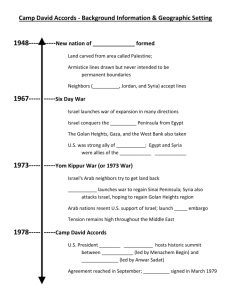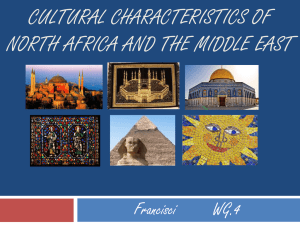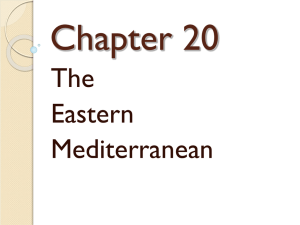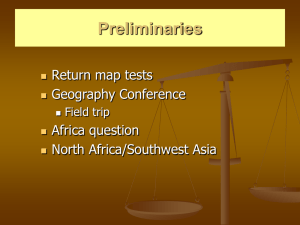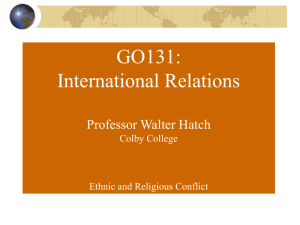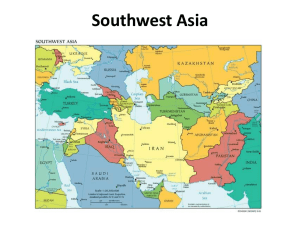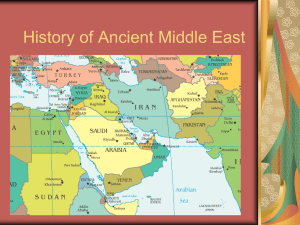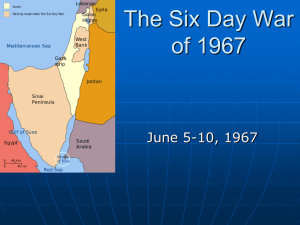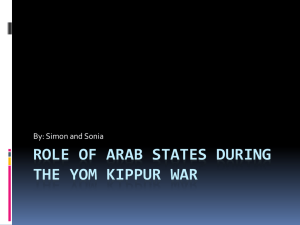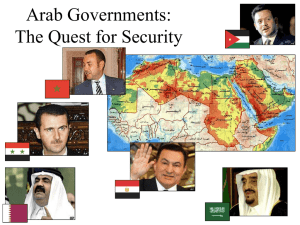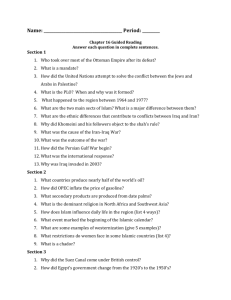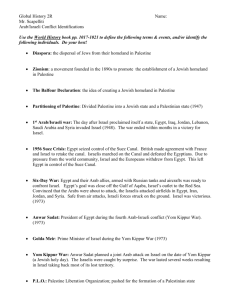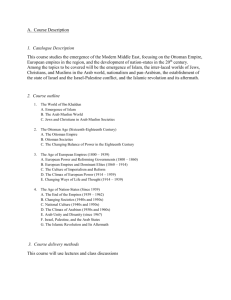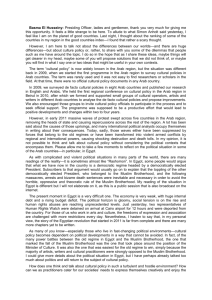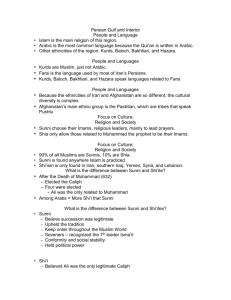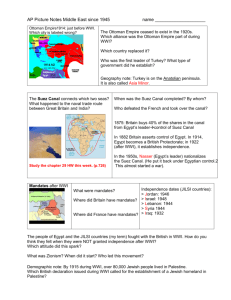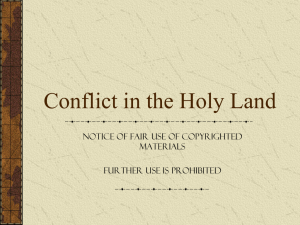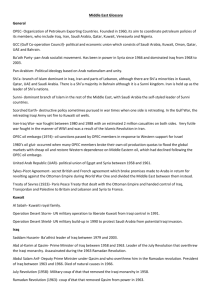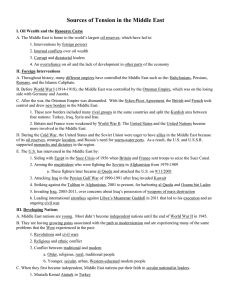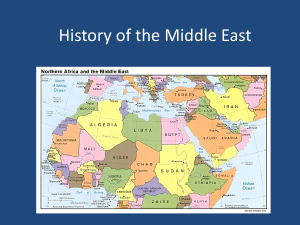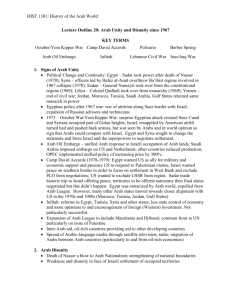History of the Middle East
advertisement
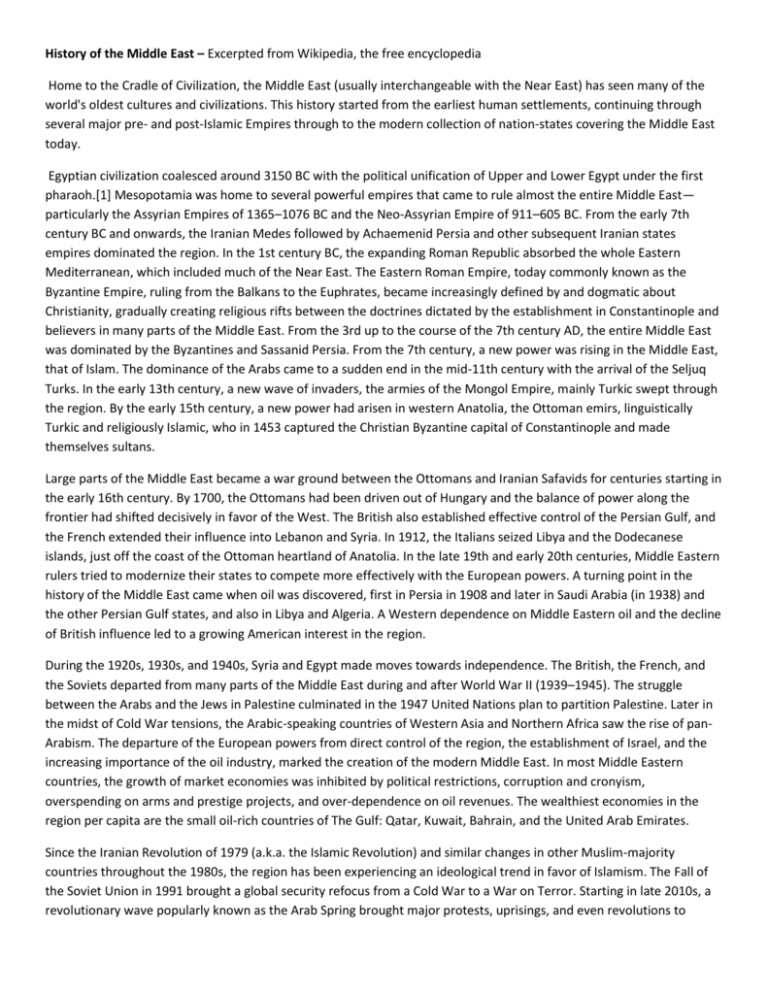
History of the Middle East – Excerpted from Wikipedia, the free encyclopedia Home to the Cradle of Civilization, the Middle East (usually interchangeable with the Near East) has seen many of the world's oldest cultures and civilizations. This history started from the earliest human settlements, continuing through several major pre- and post-Islamic Empires through to the modern collection of nation-states covering the Middle East today. Egyptian civilization coalesced around 3150 BC with the political unification of Upper and Lower Egypt under the first pharaoh.[1] Mesopotamia was home to several powerful empires that came to rule almost the entire Middle East— particularly the Assyrian Empires of 1365–1076 BC and the Neo-Assyrian Empire of 911–605 BC. From the early 7th century BC and onwards, the Iranian Medes followed by Achaemenid Persia and other subsequent Iranian states empires dominated the region. In the 1st century BC, the expanding Roman Republic absorbed the whole Eastern Mediterranean, which included much of the Near East. The Eastern Roman Empire, today commonly known as the Byzantine Empire, ruling from the Balkans to the Euphrates, became increasingly defined by and dogmatic about Christianity, gradually creating religious rifts between the doctrines dictated by the establishment in Constantinople and believers in many parts of the Middle East. From the 3rd up to the course of the 7th century AD, the entire Middle East was dominated by the Byzantines and Sassanid Persia. From the 7th century, a new power was rising in the Middle East, that of Islam. The dominance of the Arabs came to a sudden end in the mid-11th century with the arrival of the Seljuq Turks. In the early 13th century, a new wave of invaders, the armies of the Mongol Empire, mainly Turkic swept through the region. By the early 15th century, a new power had arisen in western Anatolia, the Ottoman emirs, linguistically Turkic and religiously Islamic, who in 1453 captured the Christian Byzantine capital of Constantinople and made themselves sultans. Large parts of the Middle East became a war ground between the Ottomans and Iranian Safavids for centuries starting in the early 16th century. By 1700, the Ottomans had been driven out of Hungary and the balance of power along the frontier had shifted decisively in favor of the West. The British also established effective control of the Persian Gulf, and the French extended their influence into Lebanon and Syria. In 1912, the Italians seized Libya and the Dodecanese islands, just off the coast of the Ottoman heartland of Anatolia. In the late 19th and early 20th centuries, Middle Eastern rulers tried to modernize their states to compete more effectively with the European powers. A turning point in the history of the Middle East came when oil was discovered, first in Persia in 1908 and later in Saudi Arabia (in 1938) and the other Persian Gulf states, and also in Libya and Algeria. A Western dependence on Middle Eastern oil and the decline of British influence led to a growing American interest in the region. During the 1920s, 1930s, and 1940s, Syria and Egypt made moves towards independence. The British, the French, and the Soviets departed from many parts of the Middle East during and after World War II (1939–1945). The struggle between the Arabs and the Jews in Palestine culminated in the 1947 United Nations plan to partition Palestine. Later in the midst of Cold War tensions, the Arabic-speaking countries of Western Asia and Northern Africa saw the rise of panArabism. The departure of the European powers from direct control of the region, the establishment of Israel, and the increasing importance of the oil industry, marked the creation of the modern Middle East. In most Middle Eastern countries, the growth of market economies was inhibited by political restrictions, corruption and cronyism, overspending on arms and prestige projects, and over-dependence on oil revenues. The wealthiest economies in the region per capita are the small oil-rich countries of The Gulf: Qatar, Kuwait, Bahrain, and the United Arab Emirates. Since the Iranian Revolution of 1979 (a.k.a. the Islamic Revolution) and similar changes in other Muslim-majority countries throughout the 1980s, the region has been experiencing an ideological trend in favor of Islamism. The Fall of the Soviet Union in 1991 brought a global security refocus from a Cold War to a War on Terror. Starting in late 2010s, a revolutionary wave popularly known as the Arab Spring brought major protests, uprisings, and even revolutions to several Middle Eastern and Maghreb countries. Clashes in western Iraq on 30 December 2013 were preliminary to the Sunni pan-Islamist ISIL uprising. The term Near East can be used interchangeably with Middle East, but in a different context, especially when discussing ancient times, it may have a limited meaning, namely the northern, historically Aramaic-speaking Semitic area and adjacent Anatolian territories, marked in the two maps below. New states post-World War II[edit] The British, the French, and the Soviets departed from many parts of the Middle East during and after World War II. Iran, Turkey, Saudi Arabia, and the Middle East states on the Arabian Peninsula generally remained unaffected by World War II. However, after the war, the following Middle East states had independence restored or became independent: 22 November 1943 – Lebanon 1 January 1944 – Syria 22 May 1946 – Jordan (British mandate ended) 1947 – Iraq (forces of the United Kingdom withdrawn) 1947 – Egypt (forces of the United Kingdom withdrawn to the Suez Canal area) 1948 – Israel (forces of the United Kingdom withdrawn) August 16, 1960 – Cyprus The struggle between the Arabs and the Jews in Palestine culminated in the 1947 United Nations plan to partition Palestine. This plan attempted to create an Arab state and a Jewish state in the narrow space between the Jordan River and the Mediterranean. While the Jewish leaders accepted it, the Arab leaders rejected this plan. On 14 May 1948, when the British Mandate expired, the Zionist leadership declared the State of Israel. In the 1948 Arab–Israeli War which immediately followed, the armies of Egypt, Syria, Transjordan, Lebanon, Iraq, and Saudi Arabia intervened and were defeated by Israel. About 800,000 Palestinians fled from areas annexed by Israel and became refugees in neighbouring countries, thus creating the "Palestinian problem", which has troubled the region ever since. Approximately two-thirds of 758,000–866,000 of the Jews expelled or who fled from Arab lands after 1948 were absorbed and naturalized by the State of Israel. On August 16, 1960, Cyprus gained its independence from the United Kingdom. Archbishop Makarios III, a charismatic religious and political leader, was elected the first president of independent Cyprus, and in 1961 it became the 99th member of the United Nations. Modern states[edit] The departure of the European powers from direct control of the region, the establishment of Israel, and the increasing importance of the oil industry, marked the creation of the modern Middle East. These developments led to a growing presence of the United States in Middle East affairs. The U.S. was the ultimate guarantor of the stability of the region, and from the 1950s the dominant force in the oil industry. When revolutions brought radical anti-Western regimes to power in Egypt in 1954, Syria in 1963, Iraq in 1968 and Libya in 1969, the Soviet Union, seeking to open a new arena of the Cold War in the Middle East, allied itself with Arab socialist rulers such as Gamal Abdel Nasser of Egypt and Saddam Hussein of Iraq.
